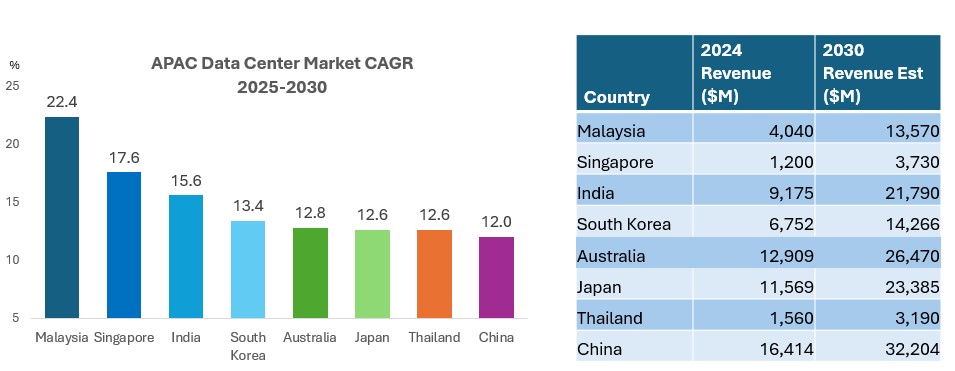
European Data Center Market Trends: Different Countries, All Growing Rapidly
Europe is next up as we summarize DataCenterHawk’s 1Q 2025 Data Center Market Recap. Demand remains strong across the region, with significant investment, particularly in emerging markets like Italy, Spain, France, and Greece, driven by factors such as AI and strategic global interconnection locations, as well as in traditional hubs like the Netherlands. While the current environment is tempered by economic and geopolitical uncertainties, long-term growth potential remains fueled by increasing demand for digital infrastructure and AI-related development.
Here’s a breakdown by country:
Italy: a key market gaining traction due to AI and its strategic location, thriving with significant investments and new developments in Q1 2025.
Milan is strategically positioned in the heart of Europe, offering excellent connectivity to France, Switzerland, Austria, and Germany. Swisscom’s €8 billion acquisition of Vodafone Italy merges the entities into the country’s second-largest telecom provider. Notable projects include:
- Microsoft is investing €4.3 billion and AWS is investing €1.2 billion to enhance their cloud presence.
- Digital Realty is establishing a 35.2 MW data center in Rome, focusing on interconnection and subsea cables.
- VIRTUS Data Centers is expanding in Milan with its first Italian facility, a 70MW campus, with construction scheduled to begin in Q2 2025.
- The Unitirreno subsea cable project, with a 480 Tbps capacity, is set to increase connectivity between Genoa, Rome, and Mazara del Vallo, reinforcing Italy’s strategic importance in Mediterranean digital infrastructure.
Spain: attracting new investments due to its easy access to renewable energy sources and robust fiber optic infrastructure.
France: attracting digital investments globally, following a recent AI summit held by President Macron. The country’s nuclear-powered energy infrastructure is a significant advantage, particularly for the development of AI-focused data centers, attracting substantial investments in AI infrastructure. While Paris and Marseille have been traditional hubs, AI is now spurring growth in other regions. Another trend involves the rise of ‘neoclouds’ constructing their own data centers away from established hubs. Notable projects include:
- Data4’s plan to build an AI data center with a capacity exceeding 1GW.
- Dataone is building an 80MW IT data center campus in Grenoble (southeast region).
- Sesterce, a GPU cloud provider, has committed to creating 1.5GW of compute power in France. Their plans include adding 600MW of capacity across two data centers in Grand Est by 2028, with a goal to reach 1.2GW and 1 million+ GPUs by 2030.
Greece: stands out as a crucial gateway between Europe, Asia, and Africa, particularly given the increasing data traffic between Eastern Europe and the rest of the continent.
The Netherlands: massive expansion moving beyond the traditional hub of Amsterdam. A lack of suitable locations is prompting operators to expand in regions such as Rotterdam, The Hague, Almere, Lelystad, and Groningen. Notable projects include:
- New facilities planned in North Holland, including a 10MW facility in Haarlem for Iron Mountain.
- NorthC is adding an additional 11 MW of IT load capacity across its data centers in Almere, Rotterdam, Aalsmeer, and Eindhoven.
Overall, the outlook for the European data center market is positive, driven by AI, cloud demand, and regional advantages, with expectations for more large-scale projects and new hubs beyond traditional markets in the coming years.
Asia Pacific: Data Center Growth Aimed Straight Up and to the Right
As with the rest of the world, the growth trajectory of the Asia Pacific region continues to point straight up and to the right. Here are the key trends:
- Continued Resilience and Growth: The APAC data center markets are demonstrating remarkable resilience amidst heightened economic uncertainty. APAC’s data center market has grown by 10% since Q4’24, increasing from 7.7GW to 8.5GW.
- Aggressive Expansion and Significant Investment: Operators and hyperscalers invested at least US$36 billion across APAC markets in the first quarter of 2025 to top out new facilities, acquire land, and pursue next-generation infrastructure.
- Land banking is accelerating as data center operators and hyperscale expansion intensifies across APAC. This is highlighted as a current and significant trend.
- Growing Emphasis on Sustainability: In developed APAC markets, sustainability has become a baseline expectation rather than just a differentiator. Major operators are implementing initiatives like deploying solar farms, issuing green bonds, and using low-carbon materials to align with stricter environmental goals.
- AI Workloads Driving Development: Demand for AI training and inference capabilities is steering a new wave of facility development across the region. APAC capacity currently under development (UC+Planned) is at an all-time high of 14.7GW, up dramatically from 11.9GW last quarter at end Q4’24. Operators are actively building AI-optimized infrastructure designed for high-density, GPU-heavy deployments.
- Robust Development Pipeline and Strong Confidence: The market is maintaining strong conviction despite broader economic uncertainty, demonstrated by robust development pipeline across the region. Hyperscaler and colocation provider activity is expected to remain high moving forward, reflecting long-term confidence in the region’s digital growth.
Here’s what’s happening by country:
Malaysia
Major hyperscalers like AWS, Microsoft, Google, and Alibaba are securing vast land parcels in Malaysia as part of their expansion strategies, reflecting rising cloud adoption and the push for localized infrastructure. Companies like Currenc Group and Treasure Global Inc. are making significant investments in AI-specific campuses for specialized, performance-driven environments for AI workloads, supported by new investment funds.
Thailand
Major hyperscalers are also securing vast land parcels in Thailand for expansion, driven by rising cloud adoption and the need for localized infrastructure to reduce latency. Thailand is home to projects focused on building AI-optimized infrastructure designed for high-density deployments, such as STT Bangkok 2.
Australia
Australia is another country where major hyperscalers are acquiring vast land parcels for expansion. Regional operators like GreenSquareDC are building future-ready campuses in key markets across Australia. ResetData’s AI-F1 factory in Melbourne caters to high-density, GPU-heavy AI deployments
Japan
Sustainability initiatives are taking root in Japan. AWS plans to invest more than US$15 billion in Japan, including plans to embed low-carbon concrete into facilities there.
Singapore
Singapore is an early adopter and leader on sustainability initiatives. Examples include Meta’s 150MW floating solar project and Equinix’s S$500 million green bond – both emblematic of integrating renewable energy and energy-efficient designs.
The Revenue Impact
Once again, we looked beyond datacenterhawk to find statistics on the revenue implications of the APAC region’s explosive data center market growth – and in this case widened the lens to include more established markets the report didn’t touch on.

Of course, China is the 800-lb gorilla in the region, dwarfing all other DC markets at $16.4 billion as of 2024 and estimated to top $32 billion by 2030. Similar mature markets Australia and Japan, growing at similar rates, will be right behind China, totaling a combined $50 billion-plus by then.
Despite power constraints, Singapore keeps going strong: the country has the second highest 2025-30 CAGR behind Malaysia, at 17.6%, with revenues estimated to more than triple by 2030, to more than $3.7 billion.
Malaysia stands out as the most promising market over the next five years, however – expected to compound at a 22.4% rate through 2030, from $4 billion in revenues to nearly $13.6 billion. Some of that will be spillover from Singapore, while other drivers will include Malaysia’s strategic location, favorable government policies, and increasing demand for digital infrastructure. Either way, look for Malaysia to rise in the ranks among APAC’s key digital infrastructure players.

